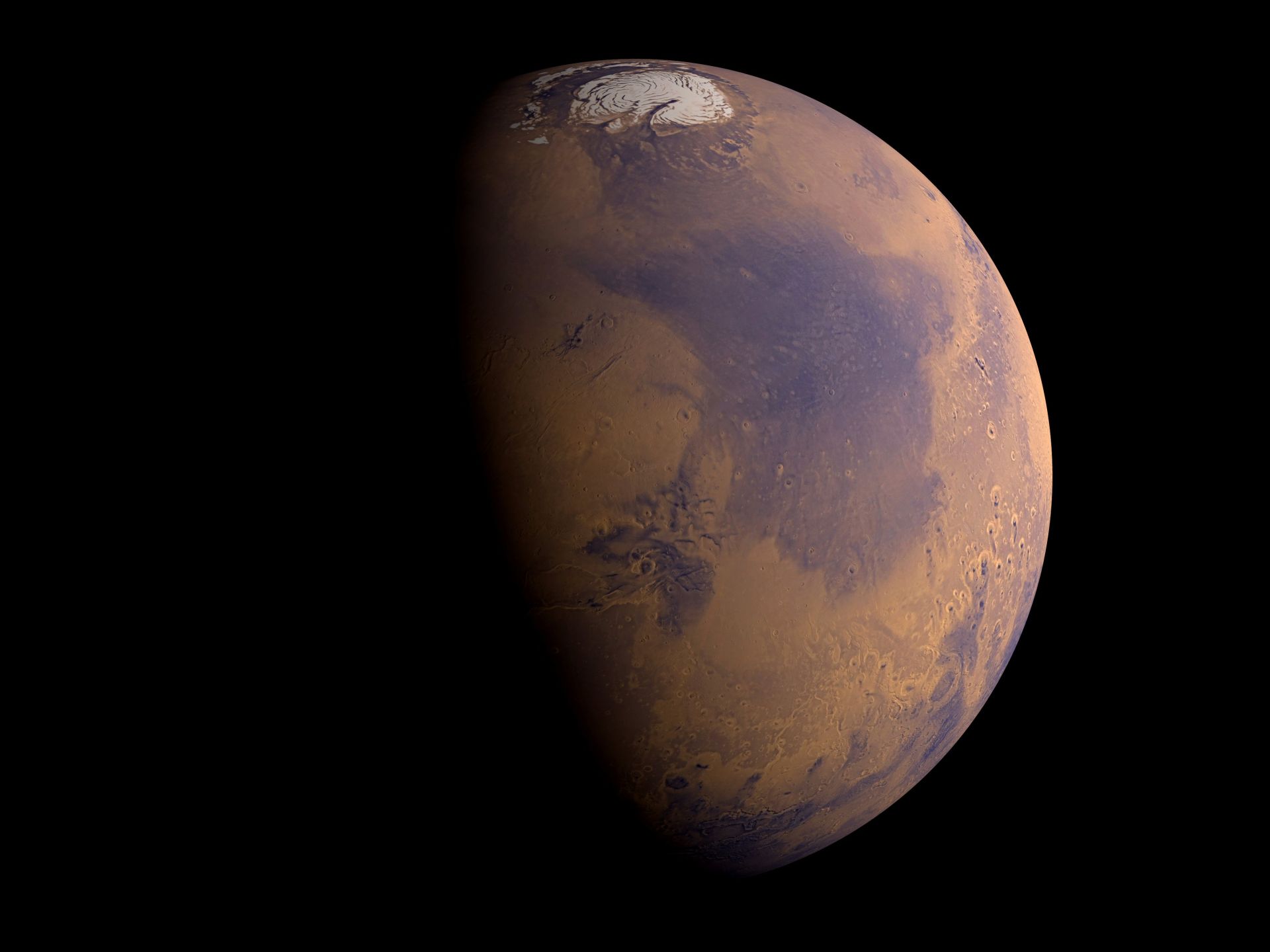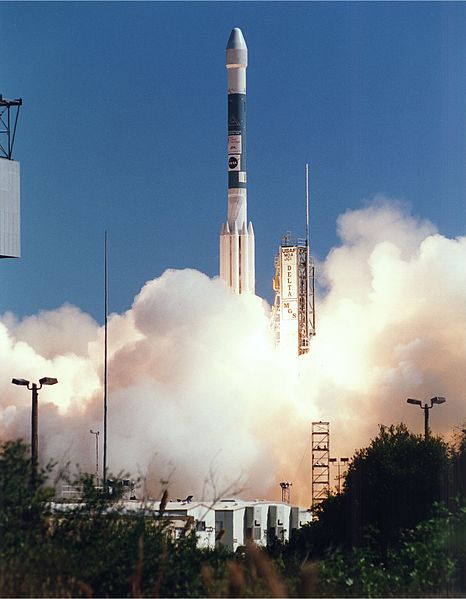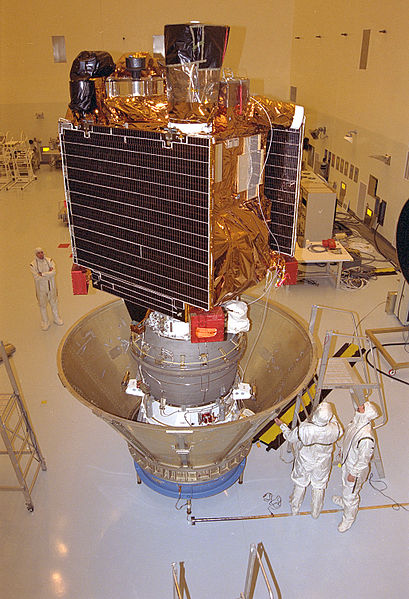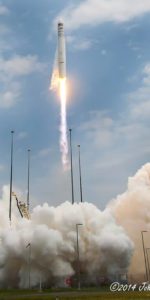
Twenty years ago, this week, NASA’s Mars Global Surveyor settled into orbit around the Red Planet, to begin what NASA described as “a sustained program of exploration” of our third-closest celestial neighbour after the Moon and Venus. Its arrival came just a few weeks after the arrival of Pathfinder—and the Sojourner rover—and signaled a remarkable shift in U.S. space policy, as an unbroken period of study of Mars study got underway. Two decades later, although Global Surveyor has long since ceased to function, that period of study continued unabated, with missions in orbit and on the ground and many more waiting in the wings for launch in the coming years. Its success today seems all the more remarkable, for the spacecraft suffered a potentially life-limiting series of problems, within hours of launch.
Global Surveyor rose from Earth at the stroke of midday EST on 7 November 1996. Launched from Cape Canaveral Air Force Station, Fla., atop a Delta II booster, it embarked on a 308-day voyage across 466 million miles (750 million kilometers) to the Red Planet and arrived on 12 September 1997. The spacecraft went on to spend more than nine years comprehensively examining Mars from its upper atmosphere to its surface, as well as offering data-relay services for later orbiters and identifying landing sites for other spacecraft. By the time Global Surveyor ended its mission in late 2006, it had spent longer in operational service at the Red Planet than any previous robotic explorer.
Built by Lockheed Martin, it was the United States’ first fully successful venture to Mars since the Viking era in the late 1970s. An earlier mission, Mars Observer, had launched in September 1992 and reached the planet the following August, but contact was lost just days before it was due to enter orbit. The $154 million Global Surveyor carried five instruments, including a camera which was of similar design to the one aboard Mars Observer. However, whereas the doomed spacecraft acquired only three images of the Red Planet, that of Global Surveyor returned no fewer than 243,668 images during its mission.

In addition to the camera, with its narrow-angle and wide-angle components, the spacecraft carried a laser altimeter for precise topographical mapping and passive radiometry, a thermal emission spectrometer—under whose infrared gaze large deposits of the important mineral olivine were discovered in the planet’s Nili Fossae region—and a magnetometer/electron reflectometer and ultrastable oscillator and a Mars Relay Signal Receiver. The latter would play a crucial role in supporting the twin Mars Exploration Rovers (MERs), Spirit and Opportunity.
Having been successfully inserted onto a heliocentric trajectory by its Delta II, Global Surveyor almost immediately ran into problems, when one of its solar arrays failed to deploy properly and was left tilted 20.5 degrees from its fully-open and latched configuration. It was not expected to impose a detrimental effect on the mission, but controllers spent several months of the trans-Mars cruise use electrically-driven positioning actuators in an attempt to gently manipulate it into infurling. By April 1997, little success had been achieved, and it became clear that the “damper arm”—part of the array’s deployment mechanism—had sheared off during Global Surveyor’s first few days in space.
The arrays, each of which included a Kapton flap at its tip for added drag, were expected to slow the spacecraft by 2,684 mph (4,320 km/h) during a four-month “aerobraking” phase to reduce its orbit from a highly elliptical path into a near-circular one. During the transit to Mars, engineers developed a new solar array configuration to complete the maneuver. On 11 September 1997, the spacecraft’s engine fired for 22 minutes to enter a highly elliptical orbit around Mars, with an apoapsis of 33,570 miles (54,026 km) over the southern hemisphere and a periapsis of 163 miles (262 km) over the northern hemisphere.
This initial orbit had a period of about 45 hours, with the expectation that it would be refined into a near-circular mapping orbit by January 1998. However, in early October, the troubled solar array exhibited significant flexion, prompting a decision to adopt a slower, “more moderate” pace for the orbit-shaping regime.
As aerobraking proceeded, the scientific harvest from Mars immediately began to flow. On 16 September, just a handful of days after MOI, scientists were able to provide the first conclusive evidence of a planet-wide magnetic field. According to early data, the field’s maximum strength did not exceed 1/800ths of the field at Earth’s surface, and carried important implications for understanding Mars’ geological history. By the end of March 1998, Global Surveyor’s orbit had been reduced to an apoapsis of 11,100 miles (17,864 km) and a periapsis of 106 miles (170 km), with a period of 11.6 hours. At this stage, aerobraking was suspended for several months, as the remainder of the spacecraft’s scientific instruments were brought online and, during suitable lighting conditions, were brought to bear on examining Viking and Pathfinder landing sites from orbit.
Aerobraking resumed in September 1998 and was completed six months later, by which time Global Surveyor occupied a near-circular orbit at an altitude of 235 miles (378 km), with a period of 117 minutes. This allowed the spacecraft to commence its primary mapping cycle on 1 April 1999, during which it extensively mapped the entire Red Planet. Over the course of the next two years (or one full Martian “year”), evidence was detected of a “layered” crust, requiring the weathering, transportation, and deposition of large quantities of material, as well as a thick mantle coating over all but Mars’ very steepest slopes. Extensive cratering was observed and inferred in the northern and southern hemispheres and Global Surveyor uncovered persuasive evidence—via the presence of hematite-rich deposits—of the existence of liquid water in Mars’ distant past. Traces of planet-wide atmospheric cooling since the Viking missions were identified and, close to the surface, the spacecraft imaged the after-effects of gigantic “dust-devils” and the presence of colossal boulders.
“In some aspects, we now have better maps of Mars than we do of Earth,” exulted Project Scientist Arden Albee of California Institute of Technology in Pasadena, Calif., speaking at the end of the two-year mapping phase in January 2001. By this stage, Global Surveyor had circled Mars 8,505 times and acquired more than 58,000 images, as well as 490 million laser-altimetry readings and 97 million spectral measurements.
A year-long extended mission got underway and was itself extended in February 2002. During this lengthened phase of Martian exploration, the spacecraft routinely performed roll maneuvers to gather targeted images away from its nadir track and photographed the vast monolith on the surface of the planet’s largest satellite, Phobos. Regions of Mars’ surface which were cloaked by dust storms during the initial mapping period were re-mapped, traces of ancient, long-dried-up rivers and possible water-borne sediments were observed and the springtime retreat of the south polar ice-cap was carefully monitored.

Astonishingly, in May 2003, Global Surveyor shuttered the first image of Earth and the Moon, as seen from Mars. From a distance of 86 million miles (139 million km), the Home Planet revealed itself as a -2.5-magnitude object, characterized by a bright patch of cloud cover over the central and eastern regions of North America. And although the far darker Moon was tougher to analyze, Global Surveyor’s images revealed slightly paler tones associated with its bright-rayed crater, Tycho.
During this extended period, NASA’s pledge of “a sustained program of exploration” was steadily realized, with the arrival of the Spirit and Opportunity rovers in the late spring of 2004. And, indeed, Global Surveyor played an integral role in their journeys across the ochre-red terrain. In September of that year, revolutionary image-compensation techniques allowed it to directly observe wheel-tracks left by Spirit at Gusev Crater. This marked the highest resolution ever obtained by a Mars-orbiting spacecraft, within 1.6 feet (0.5 meters) per pixel, far higher than the typical 4.6 feet (1.4 meters) per pixel previously achievable.
The mission was again extended for another two years in October 2004 and supported weather monitoring, which would be continued by NASA’s follow-on Mars Reconnaissance Orbiter (MRO). It also aided the selection of landing sites for the Phoenix mission and for the Curiosity rover. In the late spring of 2005, Global Surveyor became the first spacecraft to directly photograph another Mars orbiter, when it captured images of Europe’s Mars Express from a distance of 155 miles (249 km) and NASA’s Mars Odyssey from a distance of 56 miles (90 km).
Yet another two-year mission extension got underway in October 2006, but sadly Global Surveyor’s days were numbered. A month later, just days before the 10th anniversary of its launch, commands were transmitted to maneuver its solar arrays, but the spacecraft reported an error with one of its motors. On-board software transferred to a backup motor controller, but a two-day break in communication occurred on 3-4 November. Contact was re-established briefly on the 5th, during four different orbits, but no data was returned. Global Surveyor had placed itself into “safe mode” and its survival and resumption of operations depended upon restoring normal communications.
However, no further contact was established with the spacecraft, and in January 2007 NASA declared the mission to be at an end. An internal agency review found that Global Surveyor had most likely succumbed to a battery failure, triggered by a complex sequence of events involving its on-board computer memory and ground-issued commands. It was determined that depleted batteries and improper orientation of its antenna probably led to a loss of orientation control and an inability to communicate with Earth. The loss was a disappointing end to a spectacular mission which had operated longer at Mars than any previous spacecraft and which had continued to return valuable scientific data for more than four times longer than intended.
.
FOLLOW AmericaSpace on Facebook!
.






It is time to stop trying to use Mars as a P.R. device and indefinitely shelve the fantastical “Horizon Goal” of humans traveling to Mars. There is absolutely no reason for humans to go to Mars.
The Moon, a few days away, with resources to exploit, is the prize we never should have taken our eyes off of. The SLS is the Moon rocket that will take humans and worthwhile payloads to the Moon and begin a second space age.
” There is absolutely no reason for humans to go to Mars. ”
If you mean to ignore the greater quantity and variety of resources on Mars, sure.
The SLS is an utterly unneeded program which is an atrocity when it’s capabilities are compared to its cost.
An atrocity? The most powerful rocket ever built which the entire world will give the U.S. a standing ovation for when it flies. Right. The spacex groupies are the atrocity.
The entire world, eh?
Never seen you before “Zippy”, are you a sock puppet?
And we have seen you before, and we know you are yet another screen name of Gary Michael Church. On first examination, you are not a NASA employee.
Go dox yourself you jackass.
Have a fact to back you up instead of just trying to get the comments deleted because you have no facts.
http://thefederalist.com/2017/09/20/spacex-wants-pay-explore-deep-space-cant-even-explore-shallow-space/
Excuses made to retain the cost-plus business model of crony capitalists like ULA are not persuasive at a 10 fold markup to do it. Not even at only twice the cost.
” Despite massive failures, SpaceX argues it should continue to receive government contracts simply because it is the least expensive option. ”
And that is a valid reason. Every launcher familiy has had it’s early failures, ULA’s not excluded and they have twice come within a hairs’ breadth of mission failure. Their run of luck will end, same as Antares’ did.
Not a valid reason when humans are on board. You left that part of the argument out. That is the problem with spacex fans- they just don’t care about anything except the company. They are not really about space at all. It is a scam.
No it’s a valid reason then too. Not paying as much for mere transport means more money can go into safety research, also more massive systems need not be quite so on the edge of failing–it is far easier to keep safety factors high when you aren’t on the edge of not getting it done at all.
To put it simply, arguing for keeping the crony capitalist cost plus business model and it’s $5k/lb plus costs is arguing for keeping crewed and uncrewed spaceflight less safe and far less frequent.
The SLS is the scam.
Are you an asshole?
Are you se jones?
” the entire world will give the U.S. a standing ovation for when it flies ”
No, only the people who are foolish enough to think cost doesn’t matter will be sincerely applauding if it launches. Cost does matter.
You get what you pay for. Want to go to the Moon you buy the SLS. That is what they will applaud.
You want to go to the Moon with the most you can pay for, you buy trips on FHs to get you there–and can then pay for more payload.
LOL. You ain’t going to the Moon on funky falcon faux heavy Tom.
No matter matter how much you pay.
You believe that because you don’t know even basic physics. A dV is a dV is a dV.
It doesn’t matter what hardware creates it. Nothing changes the fact that LEO is delta V increment everything passes through on it’s way to anywhere else, and that what gets mass into LEO for the least $ is what means should be used and planned for.
Screaming cheap is one of those fundamental internet tactics that spacex fans have used for years to hijack these forums. Endlessly drone on about dollars per pound to orbit blah blah blah…fill up the page, fill up the page. So tired of it. And so was everybody else so they left. All you can find now is spacex infomercials on these forums.
And assholes like you
Sounds like an se jones sock puppet to me.
You’d know all about crusty socks, wouldn’t you?
What this post is talking about is a wonderful thing.
But if the SLS is funded, then there will be no more exploration, because the hardware with which to do the exploration cannot be afforded of the SLS is funded.
No exploration if the SLS is funded? What rubbish. The SLS is the exploration machine of all time.
And the rate at which the cost of the SLS program permits exploration hardware to be funded is such that the launch rate stays lows, the cost per launch stays high, so the launch rate stays low. There are currently no exploration missions funded for the SLS to lift. This will stay true. The funding of the SLS is a vicious circle of useless stupidity.
For the actual cost of only $500mn at most, two same day expendable launches of the FH from Florida and Texas permit a greater throw weight to any exploration destination that the SLS can reach, and the $500mn is the cost to the customer. $500mn per launch is the single launch cost of the SLS without any other program costs accruing, and that’s fake accoutning. The FH will unlike the SLS launch at a high enough rate it is actually a reliable system instead of a shot in the dark, and is more flexible as well, if you design the mission around re-usability, then for the same money spent you can lift the same payload weight and still have the rockets.
There is no excuse for the SLS to be funded further. There should be no more monies spent on it than to make safe the factories, lock the doors, and walk away from it.
There are no Beyond Earth Orbit human exploration missions that private space are capable of. This will stay true. The funding of commercial cargo and crew is a vicious circle of useless stupidity.
The SLS and a lunar return is where the money needs to be spent. Not a single tax dollar more should be handed over the SpaceX for their never-to-be ride to the useless space station to nowhere.
There are no BEO crewed missions NASA can afford and pay for the SLS at a rate greater than about 1 every ten years. That will stay true. The nation has a total in unfunded public liabilities of about $220tn, much of it front loaded into the next few decades. Social Security for example will only pay me about $0.70 on the dollar of what is promised, and that is an at best scenario. If you think NASA’s budget will be increased dramatically while people’s retirement checks are are being revealed to be bouncing welfare/transfer payments, you are hallucinating.
Obeying the law and spending money on far less expensive access to space via commercial crew is how more payloads are afforded.
Then NASA should be dismantled and the funding handed over to Musk…right? That is of course what all spacex fans use as a subtext when they comment. They will use any angle and say absolutely anything if they think it will advance their cult and hinder the enemies of the flagship company.
So crystal clear to anyone who has been reading space forums for any length of time.
” Then NASA should be dismantled and the funding handed over to Musk…right? ”
Not at all, there is no such subtext. But if NASA can’t run a launcher building program that is with in at least 10% of commercial cost for like capability, that program should be be defended.
For that matter, if there are at least two useful launch providers of similar cost and capability, for example SpaceX and Blue Origin, I know of no reason why NASA should attempt building launchers at all.
No such subtext….LOL.
No, no such subtext. Paying SpaceX and BO to launch payloads with otherwise SLS monies does not equal dismantling NASA.
Only an idiot would believe that.
” Paying SpaceX and BO to launch payloads with otherwise SLS monies does not equal dismantling NASA. ”
Oh really? Why do you not think with a steady budget for decades, that less needed for launchers doesn’t mean more for payloads?
Tom Perkins –
Yikes! You are still sad and mad that your Mars cult leader gave up on making Mars job number 1 for the human species and now says that we need to build a permanent human base on the Moon.
Yep, and that cult leader even said good things about the International Space Station. Wow! Who shifted his money crusted mental gears? Who jerked his gold chains? Who pulled his invisible platinum strings or cables?
Money is to be made on the Moon by tapping its vast resources and industrializing our near and dear neighbor and the valuable space between us. Lunar thorium can made into U-233 and used to efficiently power spaceships and mining colonies across our Solar System.
The Moon, and its resources and economic development, is critical to influencing world events and maintaining peace, national and international security, and encouraging our continued economic growth in Cislunar Space and eventually across our Solar System and on the Home Planet.
National Security isn’t something that makes money, but without it America can have lots of wars and other trouble that can cost millions or even billions of human lives and many trillions of dollars or even more than “$220tn” dollars on our crowded Home Planet.
Mars is the big money burning pit critical to a phony baloney Mars Soon cult that was critical to making Elon Musk richer and richer and richer through many wonderful overt and covert government subsidies dished out by his ‘good’ political ‘friend’ the former President.
That former lost in space President apparently believed that a permanent Moon base to tap its many resources was a political and economic attack by the Republicans on all the cozy and highly politically partisan ‘deals’ he wanted to put in place to insure that the Democrats would control America and create such huge political indebtedness to himself that he could command high ‘speaking fees’ forever and be ‘rewarded’ by his ‘friends’ to the tune of a hundred or two hundred million dollars.
That strange and national security ignorant anti-Moon base and anti-Cislunar Space political campaign didn’t work out so well for America. And now you loudly proclaim that Mr. Elon Musk is the new true leader of the cheap private and public flights to the Moon.
Right! OK. But I do not believe or trust you.
Sell whatever political junk garbage you want and however you want to sell it. But Mr. Elon Musk and SpaceX and super costly Mars Soon Colonies do not represent the real interests of all Americans.
The elites with tons of money love ‘Mars Colonies Soon’ because it is another great way to siphon tax and investment money into their pockets in a manner similar to their great off-shoring of American jobs over the last thirty years. Obviously, government money and assets should flow into their elite pockets and not be used for creating Lunar and Cislunar Space jobs in America for the common good of all Americans.
Taxpayer money is to be wasted in vast amounts on ill-conceived Mars colonies that have a zero business plan, will create far fewer sustainable American jobs than Lunar investments, and are supposed to be built with weak, risky, and super inefficient chemically powered spaceships built by the super government subsidized SpaceX while the American economy and people suffer under the crazy “$220tn” debt that you noted and rapidly increasing numbers of folks everywhere worrying about losing their jobs to robots.
What a perfect economic recipe for mass chaos and political instability that could cost our nation many lives and trillions of dollars.
You know Tom Perkins, selling snow in Antarctica might be much easier and more useful than trying to sell the super costly and foolish Elon Musk and SpaceX ‘Mars Colonies Soon’ plan that is currently and temporarily being thinly disguised and repackaged as ‘Cheap Flights to the Moon’.